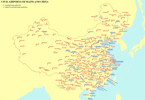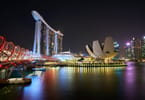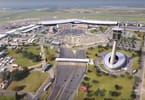The first minutes in Tanzania’s famed Ngorongoro Crater were neatly summed up by a small boy leading a herd of cattle inside the crater full of green grass.
Clad in ochre-painted cloth, the little boy from the Maasai tribe was grazing his herd of almost 200 heads of cattle and goats inside the crater full of wildlife.
A herd of zebras was grazing nearby, not far from the Maasai boy, while the fearless buffaloes were in the same grazing grounds browsing the green grass that had sprout after the long rains which hit most parts of Tanzania this year.
The crater was flat and exciting when the zebras gazed at our vehicle as if they were welcoming us to watch them. The crater looked like a big bowl, full of wild animals, giving tourists visiting this part of Africa time to contemplate the hidden secret of the creation of Earth and life.
Like the legendary Biblical Garden of Eden, the Ngorongoro Conservation Area is mostly known as the last Garden of Eden and “Home of Mankind,” and is the only place in Africa where human and wildlife have lived together sharing land resources in peace and harmony for many centuries.
Ngorongoro Crater is a famous tourist hot spot in Tanzania due to its unique attractions. Tourist attractions and the importance of the Ngorongoro Conservation Area have attracted prominent personalities including former American President Bill Clinton and former President of Cuba Fidel Castro.
The idyllic nature and landscape, the wide plains outside the crater rim, and the Maasai culture attract more visitors to this part of Tanzania, than any other location. The crater is steep, at 610 meters deep with high natural walls that survived the volcano subsidence, creating an impressive natural feature. The crater floor covers 260 square kilometers or 100 square miles of volcanic soil.
Every trip to the crater floor involves a precarious descent from the forested rim by a four-wheel-drive vehicle. Inside the crater, there is permanent water and rich pasturage maintaining a resident population of between 20,000 and 25,000 large African mammals.
The species listed as permanent residents of the crater are giraffes, the black rhinos, leopards, and nocturnal animals. Big ostriches and tens of thousands of birds fly over the crater floor and the rim.
Herds of females and juvenile elephants confine themselves outside the crater, feeding themselves in the rich, green forests on the crater rim.
Like a natural drama, a pack of hyenas was seen attacking a big mature buffalo bull. It was a wonderful real-life drama of nature. Lions were basking in the evening sun, hyenas were roaming from one point to another, and the African black rhinos were furiously gazing at the tourist vehicles.
Hippos gathered at Mandusi pool where quite frequently there are thunderous and ferocious exchanges between yellow-tusked hippo bulls hibernating inside the pool’s grey ash water.
On the other side of the crater is the Lerai Forest. Gigantic yellow-barked acacia trees beautify this natural forest. It is the permanent residence of a big bull African elephant.
Vervet monkeys are seen closer to the Lerai resting ground and picnic sites. These clever and agile creatures always mug unsuspecting tourists of their lunch boxes or fruits, as they relax to enjoy their mid-day meals.
While roaming inside the crater, a lunch box could also be picked up by lurking African kites whose haunting place is the Ngoitokitok springs, another picnic site at an open ground far from the Lerai forest. The large brown hawks have perfect aim when it comes to target swoops.
Lake Makat or Magadi (Soda Lake) is a hunting ground for lions and other predators. This lake is counted as the only place on Earth with a greater density of predators than there is prey.
The Ngorongoro Conservation Area is located 160 kilometers west of Tanzania’s northern tourist city of Arusha. This area, including the crater, covers 8,300 square kilometers of mountains, volcanic craters, highland forests, and grassy plains.
The Conservation Area was annexed from the Serengeti National Park in 1959 for multiple land use purposes to accommodate the Maasai communities and wildlife.
Together with the Serengeti National Park, the Ngorongoro supports the greatest concentration of wildlife left on Earth.
Ngorongoro Crater has high densities of wildlife throughout the year and contains the most visible population of black rhinoceros remaining in Tanzania.
Within the conservation area is the Olduvai Gorge, the site where the famous skull believed to be of the earliest man, the nutcracker man (Australopithecus boisei) was excavated in 1959 as well as the 3.6-million-year-old footprints at Laetoli.
Two of the most important, paleontological and archaeological sites in the world – the Olduvai Gorge and the Laetoli Footprint site – are found within the conservation area.
The Ngorongoro is a homeland for Maasai pastoralists and as well as Datoga and Hadzabe tribal people. It is one of the most-visited tourist destinations in Tanzania.
The multiple-land-use system is one of the earliest to be established world-wide and is emulated around the world as a means of reconciling human development and natural resources conservation.
WHAT TO TAKE AWAY FROM THIS ARTICLE:
- Like the legendary Biblical Garden of Eden, the Ngorongoro Conservation Area is mostly known as the last Garden of Eden and “Home of Mankind,” and is the only place in Africa where human and wildlife have lived together sharing land resources in peace and harmony for many centuries.
- A herd of zebras was grazing nearby, not far from the Maasai boy, while the fearless buffaloes were in the same grazing grounds browsing the green grass that had sprout after the long rains which hit most parts of Tanzania this year.
- The crater looked like a big bowl, full of wild animals, giving tourists visiting this part of Africa time to contemplate the hidden secret of the creation of Earth and life.






















